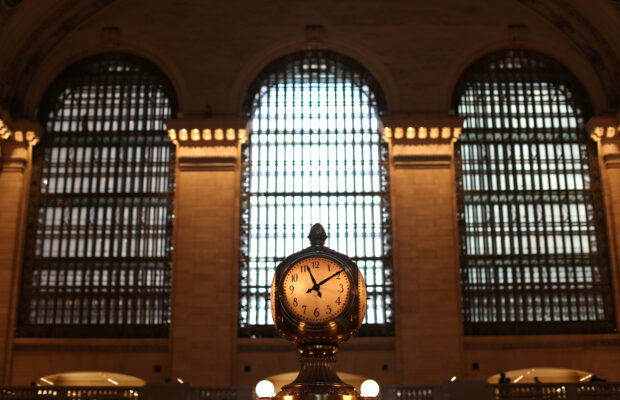Explainer: What is US daylight saving time and why was it created?

File photo: The Grand Central Terminal Clock is pictured in the Main Concourse inside Grand Central Terminal train station, in Manhattan, in New York, U.S., May 27, 2021. REUTERS/Mike Segar/File photo
As countries including the United States, Canada and Cuba prepare to set clocks back an hour on Nov. 5 as daylight saving time ends, debate is once again emerging in the U.S. over whether and how to end this practice.
Here is everything you need to know about daylight saving time and the arguments to end it.
What is daylight saving time?
Daylight saving time is the practice of moving clocks forward by one hour during summer months so daylight lasts longer into the evening. Most of North America and Europe follows the custom, while the majority of countries elsewhere, especially those close to the equator, do not.
The practice has been controversial from the outset, with many countries having adopted and rejected it multiple times. Egypt announced in March it would reintroduce daylight saving time after a seven-year gap to rationalize energy use. Japan considered adopting the practice for the 2020 Olympics but rejected the proposal due to lack of popular support and technical challenges.
When does daylight saving time end in 2023?
Daylight saving time in the U.S. and some neighboring countries will end on Nov. 5 at 2 a.m. local time, pushing clocks back an hour.
In the UK and other European countries, daylight saving time, also known as summer time, ended on Oct. 29.
Daylight saving time always starts on the second Sunday in March and ends on the first Sunday in November for the United States. This contrasts with the UK and European Union, where summer time begins on the last Sunday in March and ends on the last Sunday in October.
Why was daylight saving created in the us and how did it start?
The modern idea of changing the clocks with the seasons can be traced back to at least the late 19th century when New Zealand entomologist George Hudson proposed it to conserve energy and extend summer daylight hours, something which would have benefited his own hobby of collecting insects after work.
The idea was slow to gain traction until World War One when European states sought any strategies to conserve fuel. Germany was the first country to adopt daylight saving time in 1916 and the U.S. followed in 1918.
The practice went through many variations before the U.S. standardized it in 1966 in the Uniform Time Act, which allows states to opt out of it but not to stay on daylight saving time permanently.
A common myth is that the U.S. adopted daylight saving time to benefit farmers, but in reality many farmers are opposed to the practice for being disruptive to their schedules.
The original motivation to conserve fuel is also under debate, as studies have found little, if any, energy savings from the shift, according to the Congressional Research Service.
Opponents point to other studies that have found adverse health effects linked to daylight saving time, such as a spike in fatal traffic accidents, heart attacks, strokes and sleep deprivation in the days after clocks are moved forward an hour every March.
A March 2023 YouGov poll found that 62% of Americans want to end the practice of changing clocks, though only 50% preferred to keep permanent daylight saving time.
Do all us states observe daylight saving time?
No, Hawaii and Arizona, with the exception of Navajo Nation, do not observe daylight saving time. American Samoa, Guam, the Northern Mariana Islands, Puerto Rico and the Virgin Islands also observe permanent standard time.
While daylight saving time is widespread across the United States, 19 states have passed legislation to permanently use daylight saving time if Congress were to allow it, according to the National Conference of State Legislatures.
Is the us ending daylight saving time?
The U.S. is not ending daylight saving any time soon, though there is an effort in the federal government to pass the so-called Sunshine Protection Act, which would make daylight saving time permanent.
The act, which a bipartisan group of senators introduced in 2022, was passed unanimously by voice vote but stalled in the U.S. House of Representatives because lawmakers could not agree on whether to keep standard time or permanent daylight saving time, said Representative Frank Pallone in March.
The group of senators reintroduced the bill again this year and it has been referred to the Committee on Commerce, Science and Transportation to review. The bill would need to pass the Senate and House of Representatives before President Joe Biden can sign it into law.